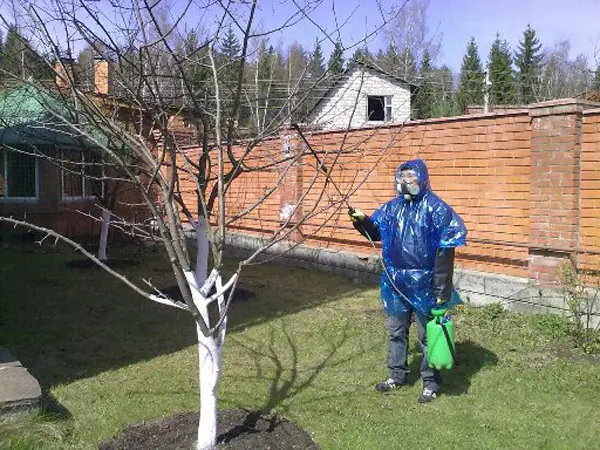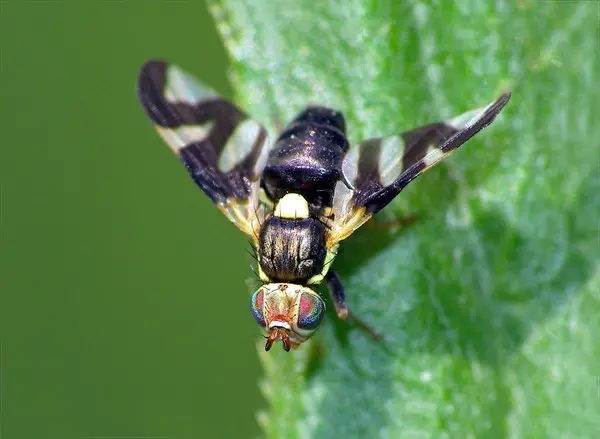Contents
Cherry trees are a tasty morsel for a variety of parasites. Cherry pests affect all parts of the plant, the trunk, foliage and fruits themselves suffer. So that the stone fruit does not die completely and can please you with fruits in the future, it is necessary to carry out special treatments. And if you want to know how to treat cherries from pests, when and how to deal with them, check out this article.
Cherry processing rules
In order for the cherry to grow healthy and give full fruits, it needs proper and regular spraying throughout the year.
When to Process
Spring spraying is carried out to preserve the flowers and emerging ovaries. In order to avoid burns of the bark and leaves, it is recommended to carry it out in early spring, while the buds are still sleeping and active sap flow has not begun. Most often, a solution of urea is used (concentration: 700 g of the drug per 10 liters of water), spraying both the tree itself and the soil under it. Once a month, you can use biological products – “Fitoverm”, “Akarin”, “Healthy Garden”.

Works in the garden in autumn are, first of all, prevention, aimed at the destruction of the main number of parasites, and also prevent the emergence and spread of infectious and viral diseases. Autumn processing includes several stages:
- after all the foliage has fallen from the cherry, pruning of diseased and deformed branches is carried out. The places of cuts must be covered with a garden pitch;
- if there are cracks on the tree, from which gum is released, it is also necessary to cover them up;
- fallen leaves, branches cut by you, should be collected and destroyed;
- as soon as the first frosts pass, the garden must be treated with a 5% solution of urea. This highly concentrated fertilizer can destroy both all kinds of pests and pathogens that cause fungal and infectious diseases. It is necessary to spray both near-stem circles and crowns.
How are trees processed?
In early spring, the following drugs are used:
- copper sulfate. To prepare the solution, you need to dilute 100 g of fertilizer in 10 liters of water.
- 3% Bordeaux mixture diluted in 10 liters of water.
- inkstone. To prepare an active solution, it is necessary to dilute 300 g of fertilizer in 10 liters of water.
In autumn, experienced gardeners use an ancient folk method, spraying the garden with diesel fuel. Before use, it must be diluted in water so as not to cause burns during processing.
Urea is also used (concentration: 700 g of fertilizer per 10 liters of water). Spraying the finished solution should be very fine.
Remember that in the fall, all spraying must be completed before the first frost.
cherry pests
The plant, like most fruit-bearing ones, has a lot of enemies that destroy or damage the ovaries, leaves, fruits and bark. Consider the most dangerous parasites.
Weevil
This type of pest (also called the cherry pipeworm) is common everywhere. He is the first to harm the kidneys that have not yet awakened. In the process of flowering, the tree attacks flowers, young leaves and ovaries. If the weevil is not removed in a timely manner, crop loss is guaranteed in most cases.
Ways to deal with a tube turner includes several stages. With the advent of autumn, remove the old, exfoliated bark from the tree, and treat the cleaned places with lime. Be sure to burn the bark removed in this way and all fallen leaves. The soil around the roots should be dug up. It is in the root soil that the bulk of weevils are located for wintering. Do not miss the period of bud maturation. At this point, you can get rid of a large number of weevils. To do this, you just need to gently shake them off the swollen kidneys onto a pre-prepared sheet.
In the fight against parasites, insecticides are actively used. For maximum effect, it is recommended to treat immediately after flowering.
They also use such a folk method as spraying with a concentrated 10% karbofos (70 g of the substance per 10-liter bucket of water) or a 10% mixture of trichlormetaphos-3 (70 g of the substance per 10-liter bucket of water). Spraying is carried out at weekly intervals.
Also a good way to get rid of the pest is to spray a solution of field chamomile. To do this, you need to pour 150 g of chamomile flowers into 15 liters of water. The resulting solution is insisted for a day, then filtered and 60 g of ordinary laundry soap are added.
Slimy sawfly
If you find larvae on the leaves that resemble leeches in their appearance, you should know that this is a slimy sawfly. It damages only the upper side of the foliage (epidermis), and does not touch the lower skin and veins of the leaf. The leaves damaged by the sawfly quickly dry out, young shoots do not ripen, and the fruits fall off prematurely.
In order to prevent the appearance of a pest, it is necessary to do autumn digging of the soil. In the summer, loosening of the soil is carried out in the near-stem circles of cherries. To combat the sawfly, drugs such as Fufanon or Kemifos are used. To prepare active solutions, it is necessary to dissolve 10 ml of active substances in 10 liters of water. But remember, they start processing only if the pest has infected more than 10% of the plant’s foliage. If it is less, then they do not resort to chemical treatment, since the number of parasites will not affect the formation and ripening of the berry crop.
leaf aphid
This pest is a small larva that has a black or green color. It affects leaves and young growths. She actively sucks tissue juice from the foliage. For this reason, the leaves begin to slow down their growth, gradually lose moisture, dry out and curl into a tube.
For the fight, an infusion of tobacco is used, to which laundry soap is added. The tool is able to limit the movement of the parasite. Fitoverm is also effective (1 ml of the drug is required for 2 liter of water), Intavir, to prepare a solution, 10 tablet of the drug is added to 1 liters of water.
Be aware that the abuse of nitrogen-containing fertilizers can provoke excessive reproduction of aphids. But excess potassium- and phosphorus-containing fertilizers can reduce the rate of reproduction of the parasite. Therefore, feed according to the needs of the fruit tree.
Video “Fighting aphids in the garden”
This video will show what control methods are used against garden aphids.
butterfly hawthorn
This white butterfly is very similar to cabbage. She actively eats buds and foliage. And as a result, the branches of the tree are exposed. Usually in winter right there, on trees, it settles down for wintering in nests. It is advisable to collect and destroy them. Spraying against hawthorn begins before the young buds bloom. Both chemical (Aktellik, Ambush) and biological preparations are used. Spraying is carried out twice: in spring and at the end of August.
Plum moth
This pest is a large light brown butterfly. She lays her eggs in still immature fruits. The hatched caterpillars begin to actively and massively eat the fruits, and as a result, wormy cherries and spoiled crops. If clutches of codling moth eggs are found, treat with carbophosphate or benzophosphate.
cherry fly
It looks like an ordinary housefly, only smaller in size. It feeds on medium and late varieties of cherries. Can damage up to 30% of cherry fruits. As soon as you find that depressions or softening have appeared on the fruits, this is the “work” of the cherry fly. The larvae of this parasite eat late varieties of cherries. Pesticides such as Diazinon, Dimethoate, Spinosad are used to fight.

The Golden-fleece
This pest butterfly has another name – Golden silkworm. In the traces of damage to the foliage, it resembles the damage left by the hawthorn. Caterpillars that emerge from eggs laid by butterflies feed on foliage. Damaged, skeletonized leaves are wrapped in cobwebs and firmly attached to the branches, where the caterpillars hibernate. With the advent of spring, they crawl out of the nests and damage young buds.
When foliage is found in the web, it is necessary to cut off and destroy them. Sprayed with a 0,3% solution of karbofos.
If you find parasites in your garden, remember that the site needs care and help in the fight against parasites. Carry out the processing of the garden, but remember the timing of its implementation. After all, untimely spraying will not bring the expected results. Also, do not use several chemicals at the same time. Fight only those pests that you found in your garden a year ago or this season. Spraying should not be used “for safety net”, “just in case”. During the flowering period, try not to resort to chemical treatment of the tree – this can lead to the death of bees, the plant will remain unpollinated, which will lead to crop loss.









